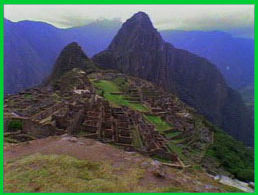 |
 |
 |
 Lost Empire
Lost EmpirePart 3 (back to Part 2) Machu Picchu What remains of the Inca legacy is limited, as the conquistadors plundered what they could of Inca treasures and in so doing, dismantled the many structures painstakingly built by Inca craftsmen to house the precious metals. Remarkably, a last bastion of the Inca empire remained unknown to the Spanish conquerors and was not found until explorer Hiram Bingham discovered it in 1911. He had found Machu Picchu, a citadel atop a mountainous jungle along the Urubamba River in Peru. Grand steps and terraces with fountains, lodgings, and shrines flank the jungle-clad pinnacle peaks surrounding the site. It was a place of worship to the sun god, the greatest deity in the Inca pantheon.  A High Altitude Culture
A High Altitude CulturePerhaps most unique about Inca civilization was its thriving existence at altitude. The Incas ruled the Andean Cordillera, second in height and harshness to the Himalayas. Daily life was spent at altitudes up to 15,000 feet and ritual life extended up to 22,057 feet to Llullaillaco in Chile, the highest Inca sacrificial site known today. Mountain roads and sacrificial platforms were built, which means a great amount of time was spent hauling loads of soil, rocks, and grass up to these inhospitable heights. Even with our advanced mountaineering clothing and equipment of today, it is hard for us to acclimatize and cope with the cold and dehydration experienced at the high altitudes frequented by the Inca. This ability of the sandal-clad Inca to thrive at extremely high elevations continues to perplex scientists today. The Conquest How did Pizarro and his small army of mercenaries, totaling less than 400, conquer what was becoming the world's largest civilization? Much of the "conquest" was accomplished without battles or warfare as the initial contact Europeans made in the New World resulted in rampant disease. Old World infectious disease left its devastating mark on New World Indian cultures. In particular, smallpox spread quickly through Panama, eradicating entire populations. Once the disease crossed into the Andes its southward spread caused the single most devastating loss of life in the Americas. Lacking immunity, the New World peoples, including the Inca, were reduced by two-thirds. With the aid of disease and the success of his initial deceit of Atahualpa, Pizarro acquired vast amounts of Inca gold which brought him great fortune in Spain. Reinforcements for his troops came quickly and his conquest of a people soon moved into consolidation of an empire and its wealth. Spanish culture, religion, and language rapidly replaced Inca life and only a few traces of Inca ways remain in the native culture as it exists today. The Lost Empire | The Sacrificial Ceremony | High Altitude Archaeology | Burial Artefacts Photos: (2) courtesy Michael Barnes. Expedition '96 | Dispatches | Mummies | Lost Worlds | Mail Resources | Site Map | Ice Mummies of the Inca Home | BBC Horizon Editor's Picks | Previous Sites | Join Us/E-mail | TV/Web Schedule About NOVA | Teachers | Site Map | Shop | Jobs | Search | To print PBS Online | NOVA Online | WGBH © | Updated November 2000 |